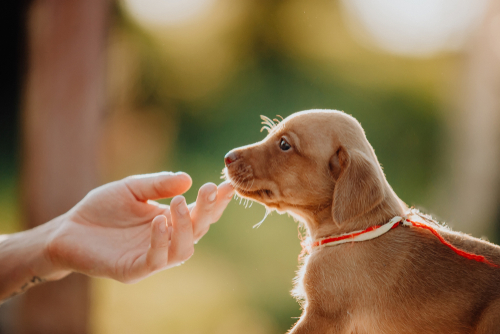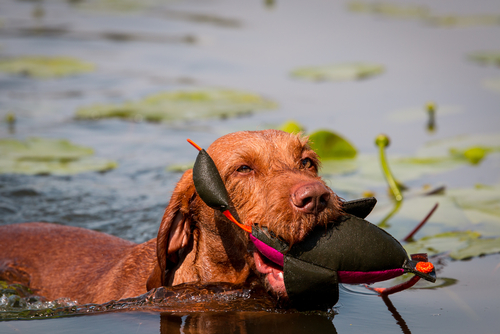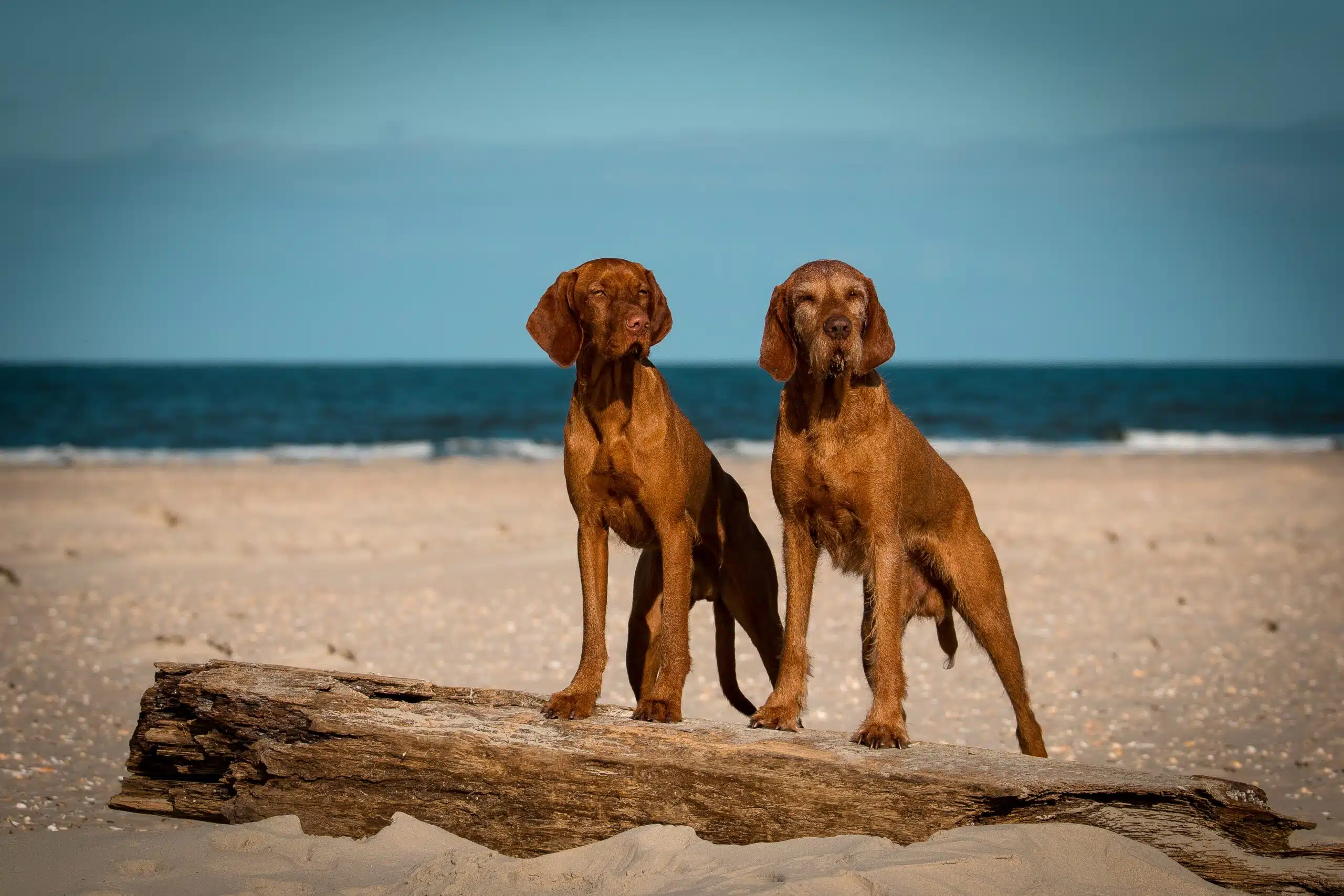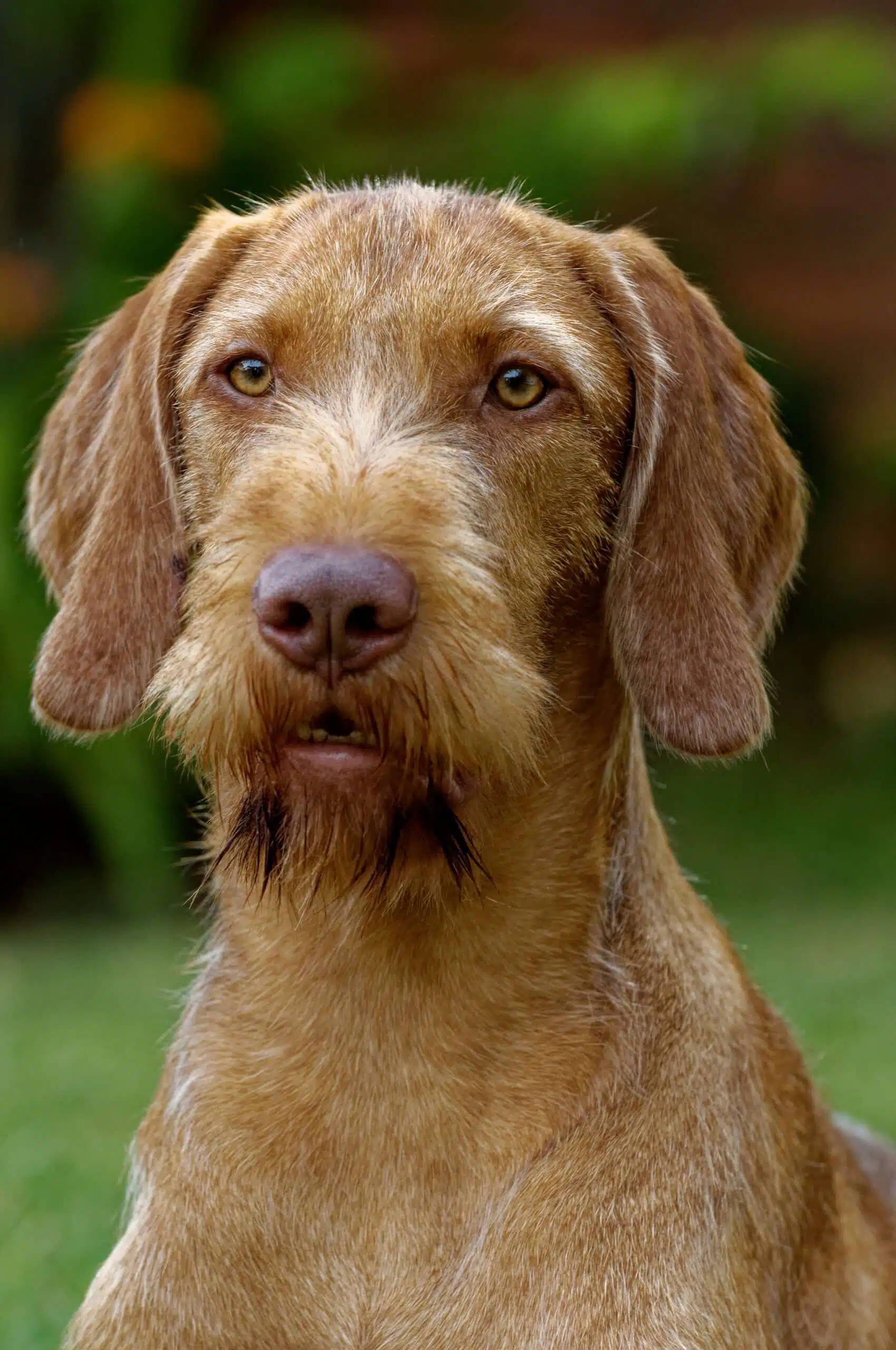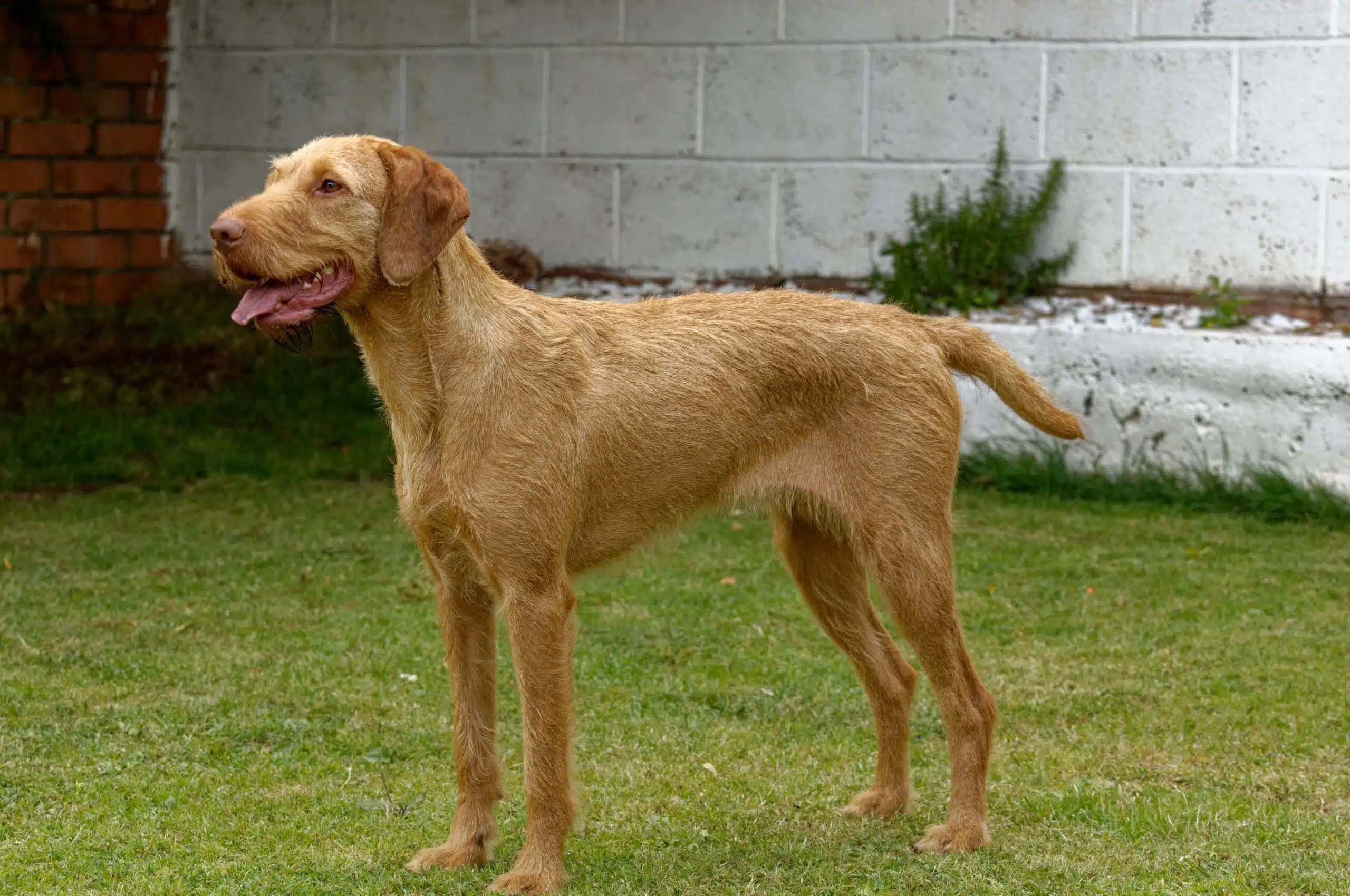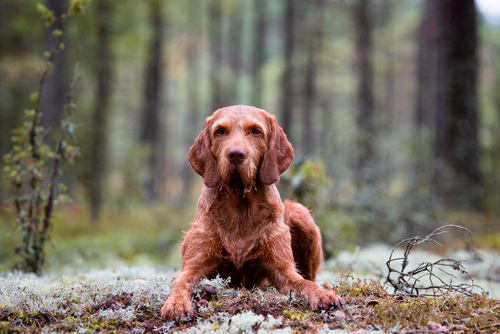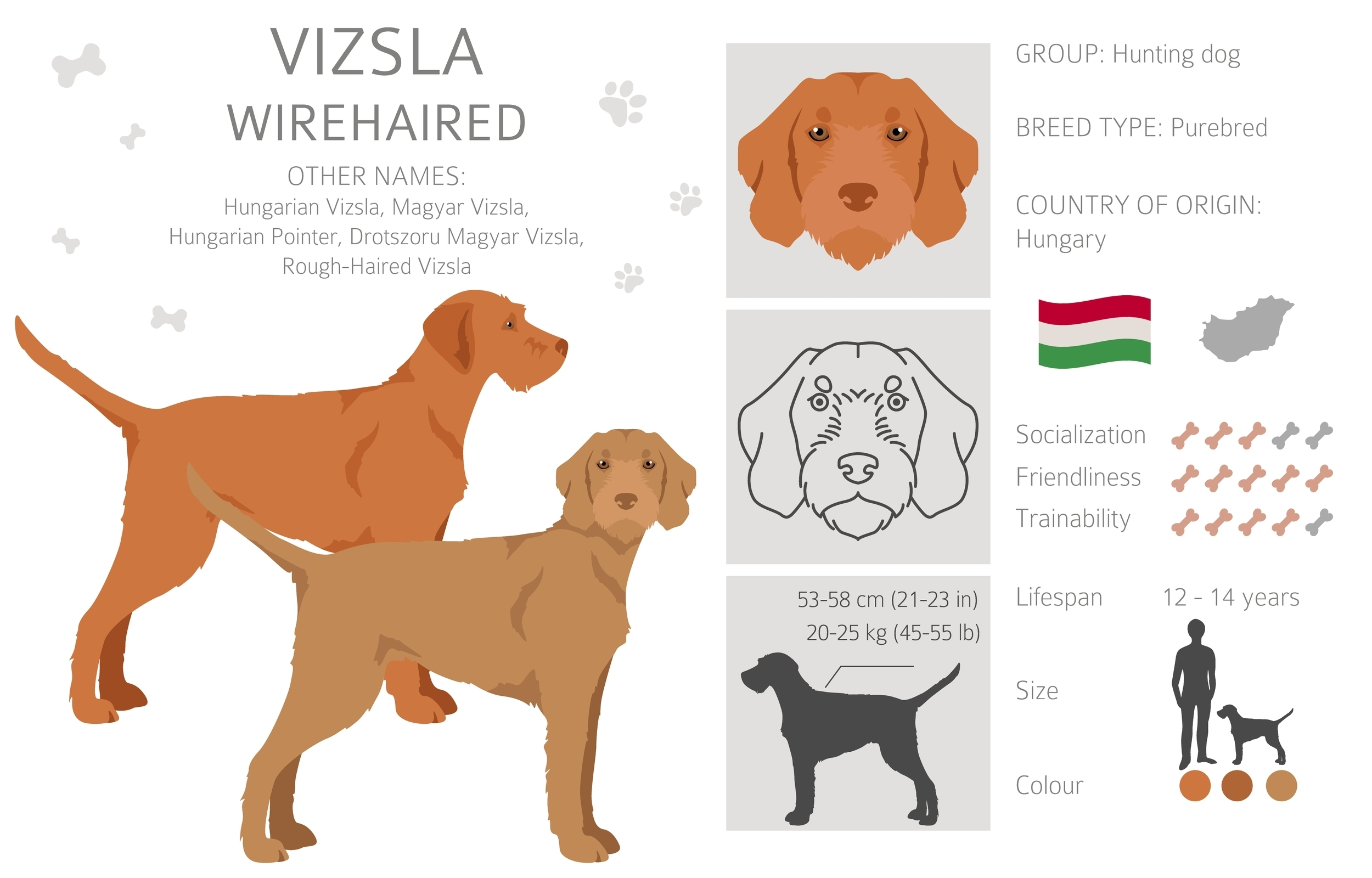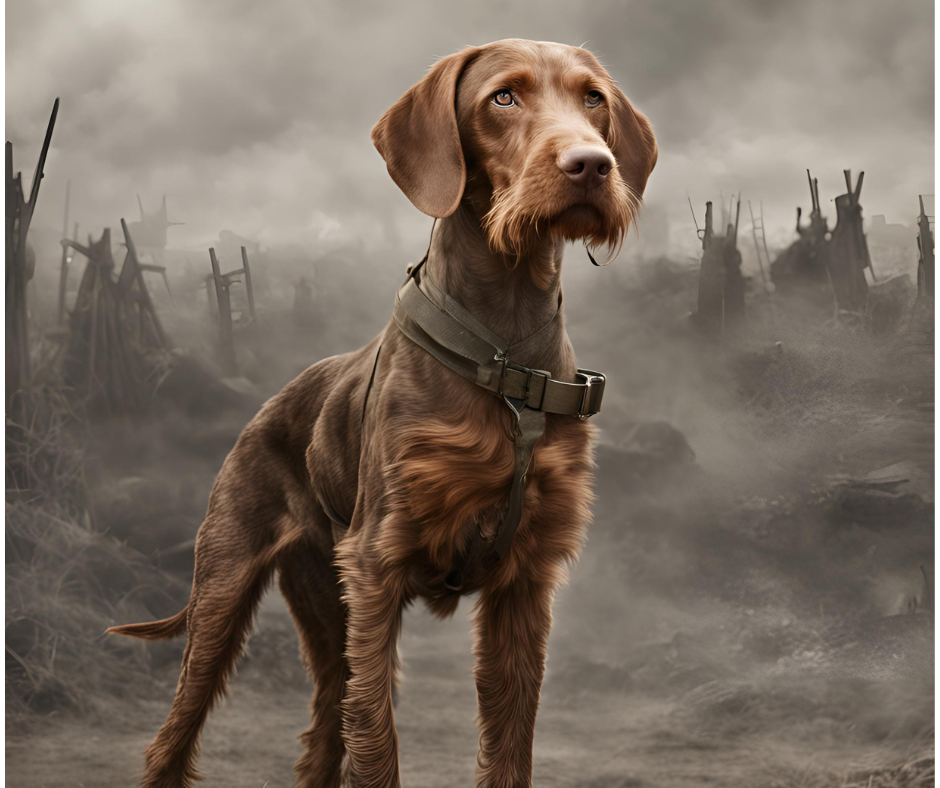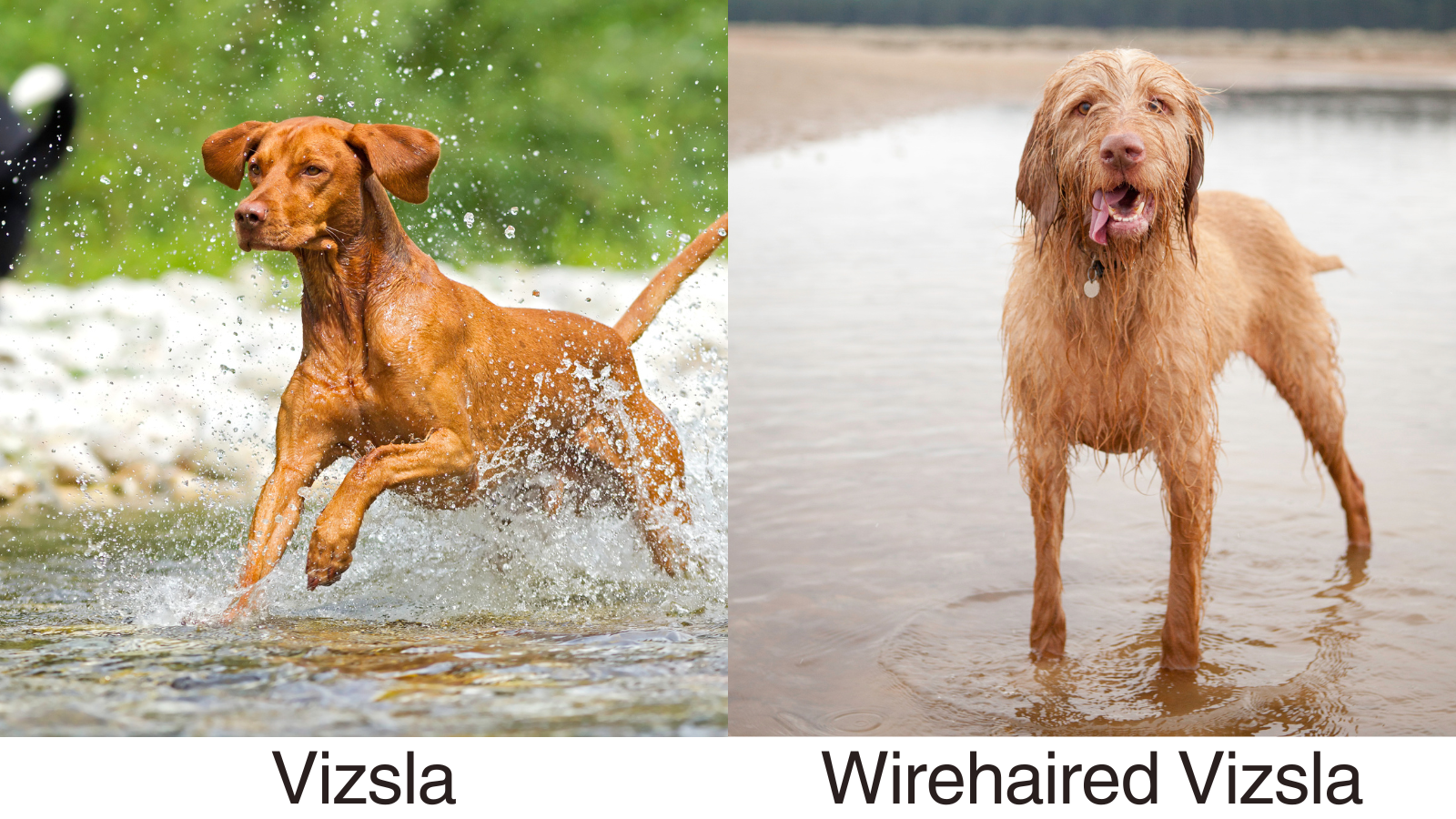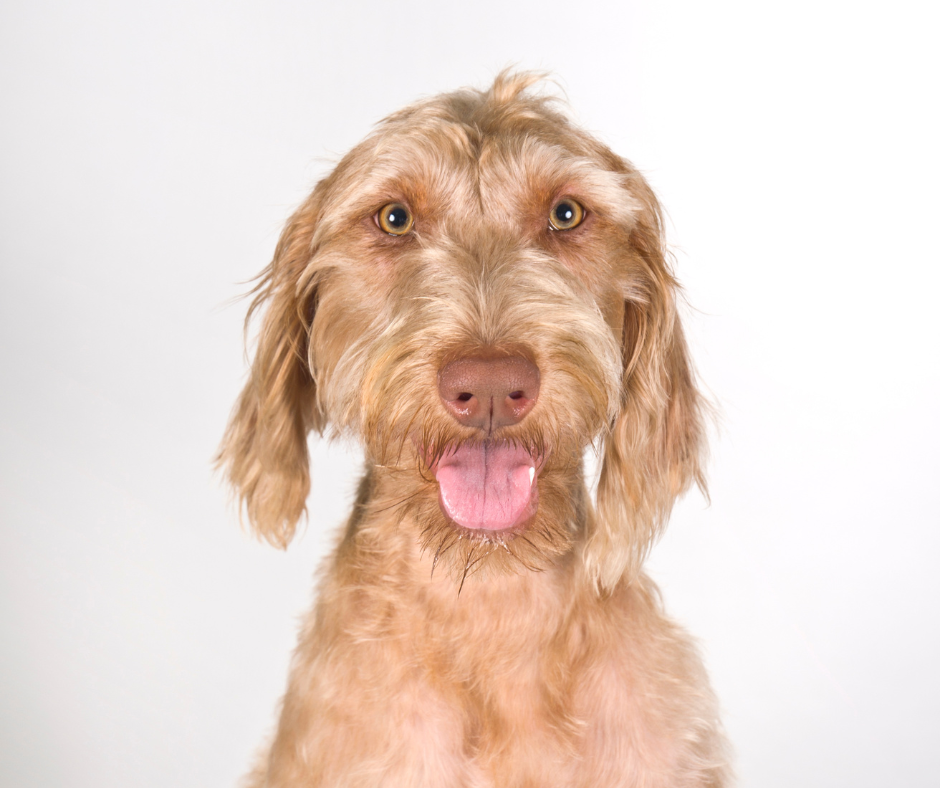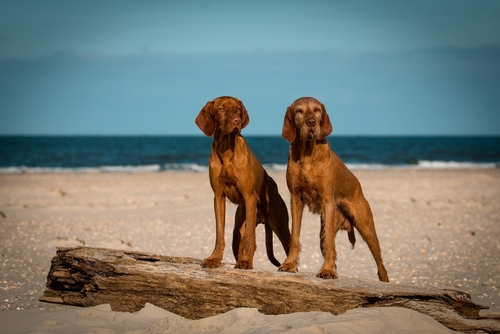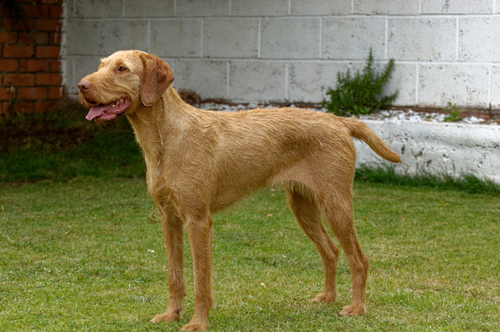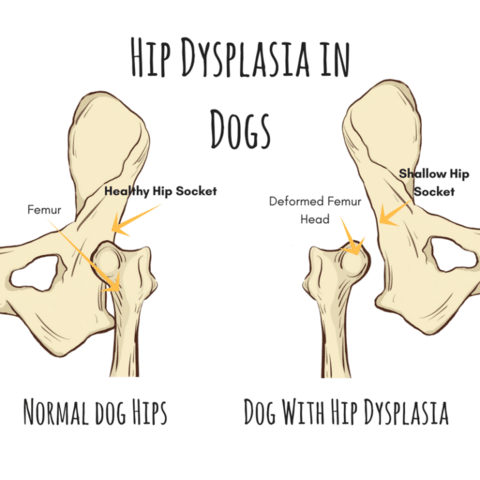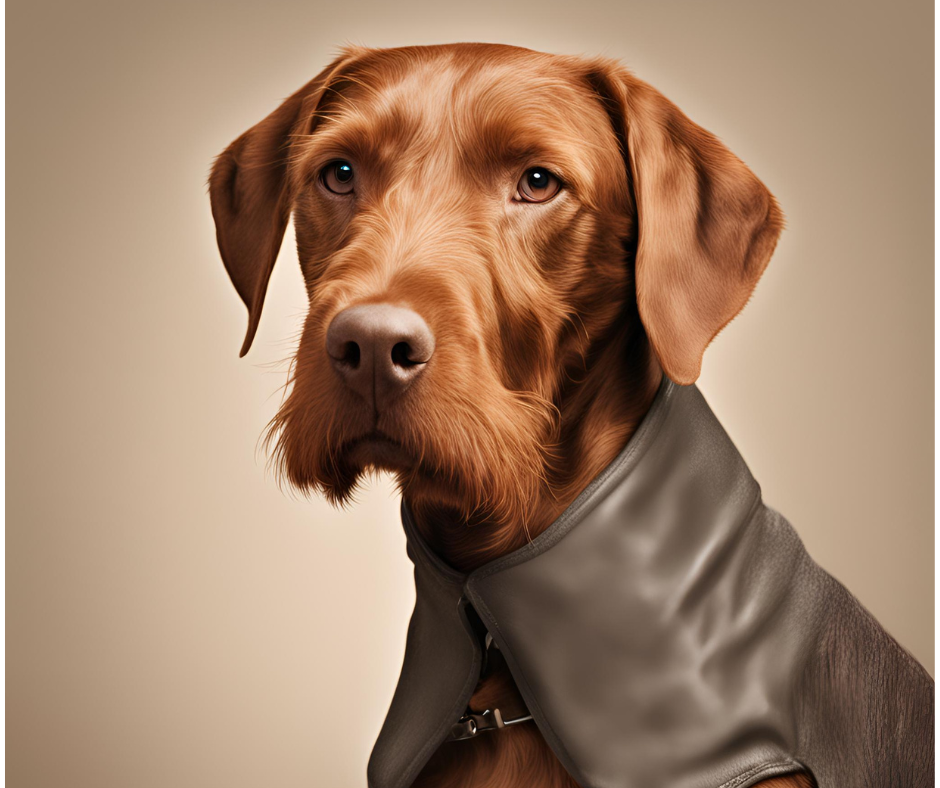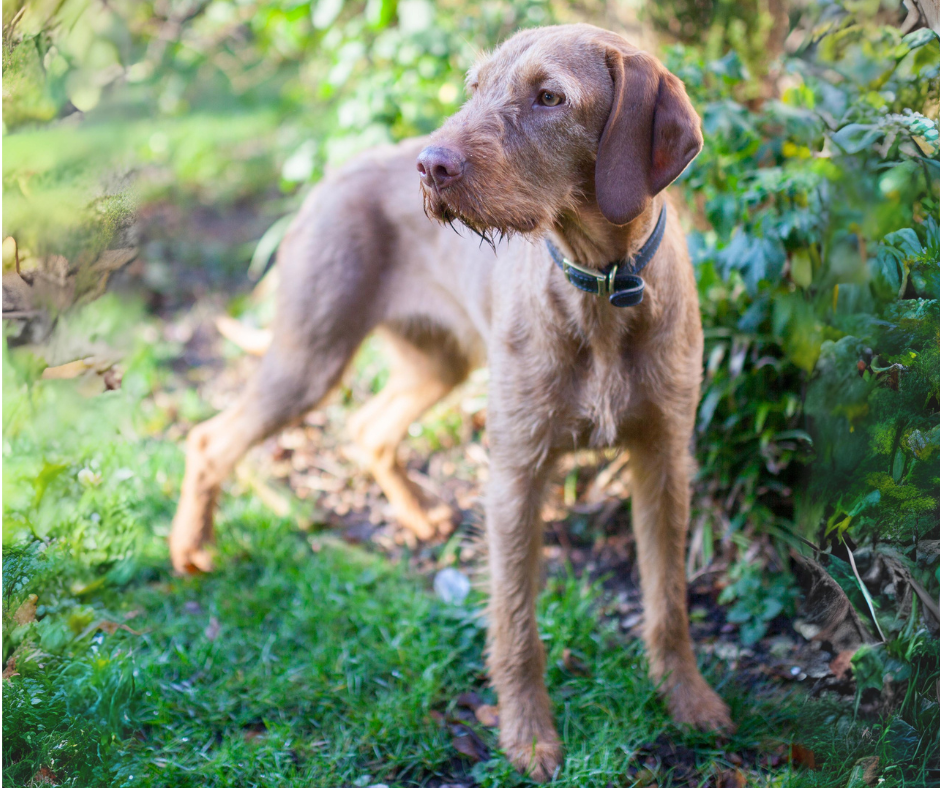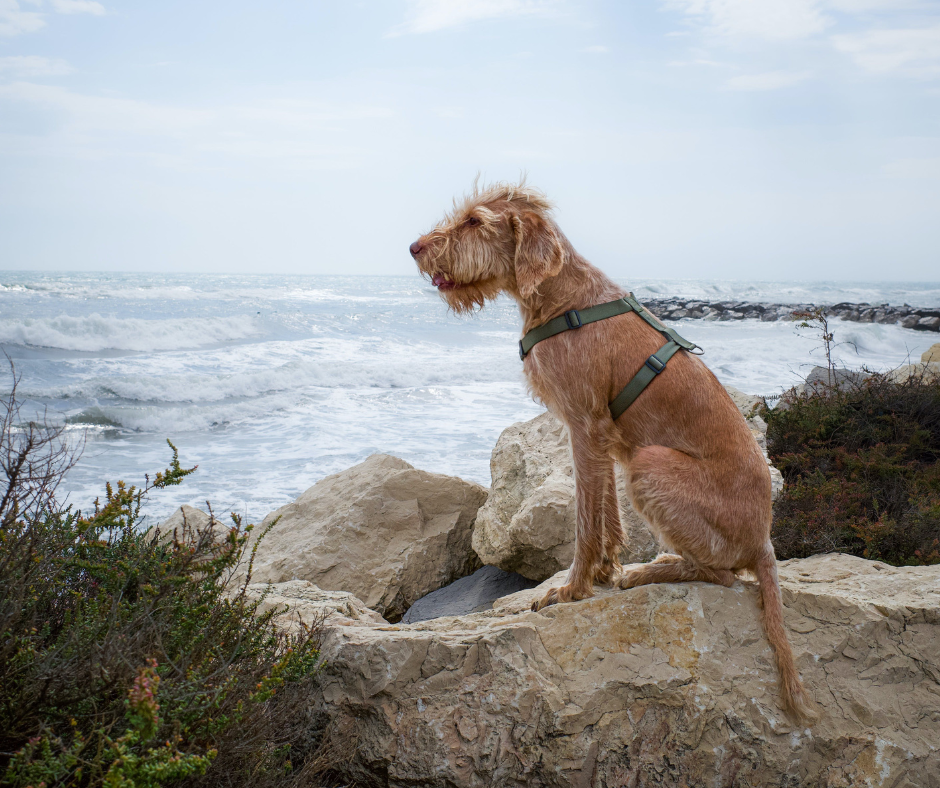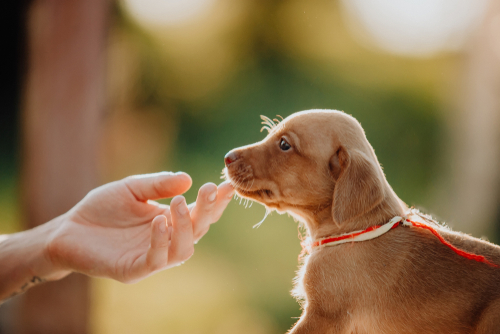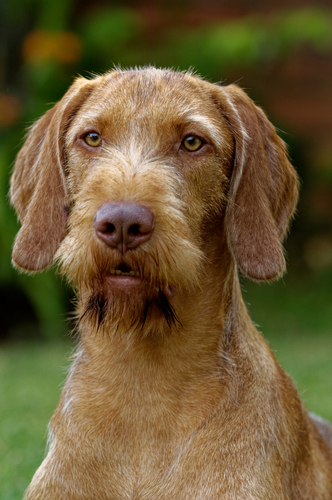Wirehaired Vizsla
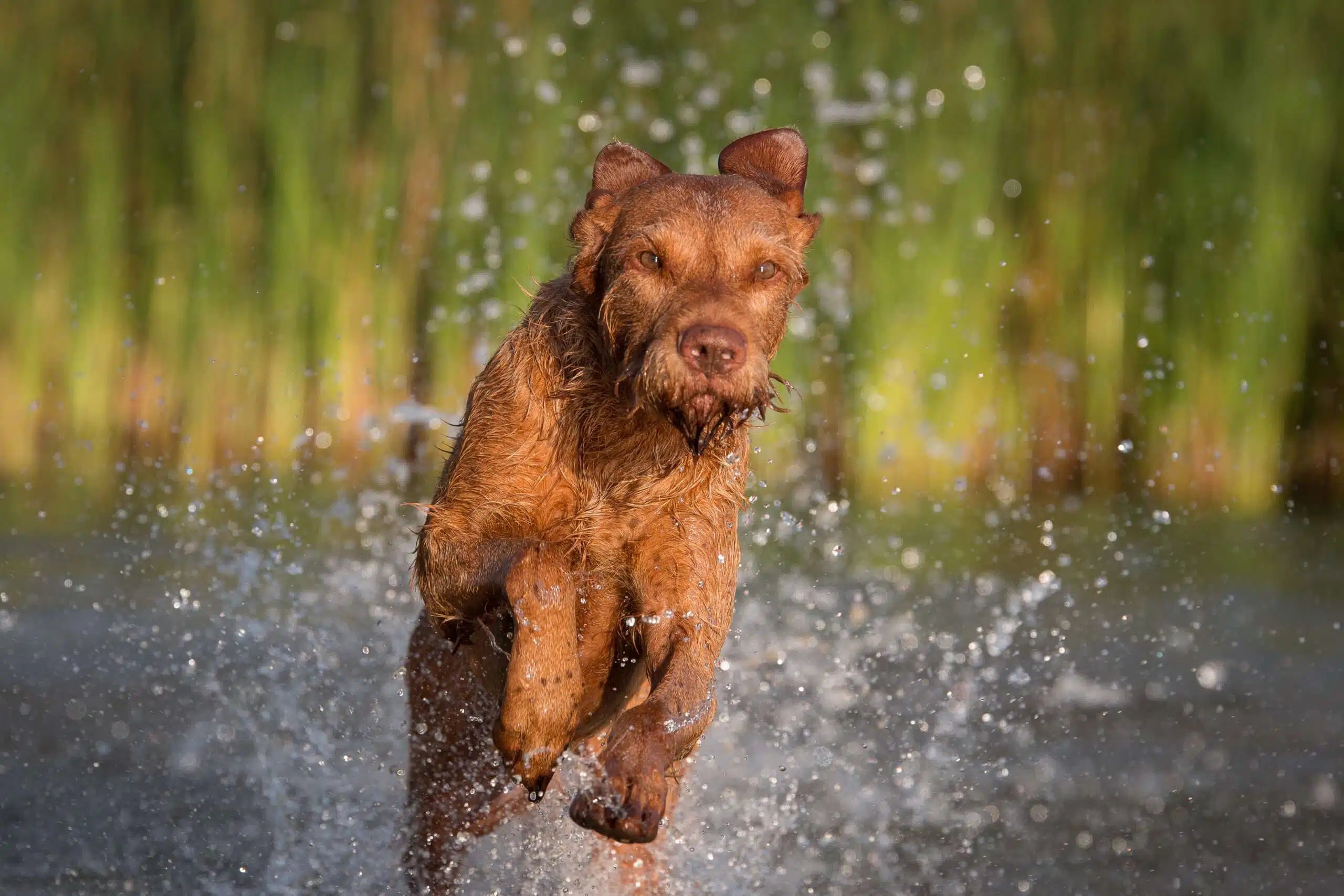
The Wirehaired Vizsla, developed in Hungary in the 1930s, is a beloved breed known for its unique characteristics and affectionate temperament. Hungarian hunters and falconers bred the Wirehaired Vizsla to endure harsh northern Hungarian winters. They aimed to combine the Vizsla’s hunting instincts and signature golden-rust color with a tougher, wiry coat for better protection against rugged terrains. They achieved this by crossing smooth-coated Vizslas with the German Wirehaired Pointer, Pudelpointer, Wirehaired Pointing Griffon, Irish Setter, and possibly the Bloodhound.
The result was an exceptional gundog capable of tracking and retrieving with ease across fields, woodlands, and water. Although related to the Vizsla, the Wirehaired Vizsla is recognized as a separate breed. It is popular among hunters but also makes a loyal family pet, given proper training and enough time for play and activities. This breed thrives on attention and loves affection from all family members.
The Wirehaired Vizsla is versatile, excelling in agility, obedience, tracking, dock diving, and even therapy work. Its resilient constitution also makes it suitable for hiking and backpacking. Owners often report their dogs excelling in multiple disciplines.
When well-socialized, this breed displays a mild temperament around children and can befriend other dogs and cats with early exposure. Potential owners should meet the breed and observe them in their home environment. An interview with a breeder is essential to ensure your lifestyle aligns with the dog’s need for mental stimulation and physical activity. Without sufficient attention, they can become bored and destructive, so they require a dedicated, active family.
Wirehaired Vizsla: The Resilient and Affectionate Gundog Excelling in Every Field
The Hungarian Wire-Haired Vizsla, or Hungarian Wirehaired Vizsla, stands out among hunting dogs due to its distinctive wiry coat and robust build. Bred in Hungary to handle cold climates and larger hunting territories, the breed’s coat and hunting instincts were enhanced through strategic breeding, incorporating breeds like the German Wirehaired Pointer.
In sports and agility competitions, the Wirehaired Vizsla excels in tracking, pointing, and retrieving. Its blend of stamina, speed, and intelligence, combined with a strong sense of smell and eagerness to please, makes it a top contender in field trials and agility courses. Its athleticism and agility allow it to navigate obstacles with precision.
Key Takeaways:
- Distinctive Coat: A dense, wiry coat provides extra protection in cold climates and rough terrain.
- Strategic Breeding: Incorporation of other breeds, like the German Wirehaired Pointer, enhanced the coat and hunting instincts. Read more on the history of breeding.
- Versatile Sports Competitor: Excels in tracking, pointing, and retrieving due to stamina, speed, and intelligence.
- Athleticism: High energy and agility make the breed suitable for challenging sports demanding mental and physical prowess.
These qualities not only fulfill the practical requirements of hunting and competitive sports but also reflect the breed’s deep-rooted history in game hunting and fieldwork. As we delve deeper into the origins and historical roles of the Hungarian Wire-Haired Vizsla in the following sections, the breed’s profound connection to Hungary’s sporting and cultural heritage becomes increasingly apparent.
Origins and Early Development of the Hungarian Wirehaired Vizsla:
The Wirehaired Vizsla’s historical journey begins in early 20th-century Hungary when there was a strong interest in breeding dogs suited for specific hunting conditions. In the 1930s, the desire for a robust hunting dog capable of working in harsh terrains and cold weather led to the development of the Hungarian Wire-Haired Vizsla. Breeders aimed to combine the Hungarian Vizsla’s traits with the German Wirehaired Pointer’s resilience and coat characteristics. The Hungarian Vizsla Klub played a pivotal role in the breed’s development, overseeing the submission and approval of a development plan with conditions, highlighting its significant influence in the breed’s evolution in Hungary.
Initial Breeding Program
A female Vizsla named ‘Csibi’ and a male German Wirehaired Pointer named ‘Astro’ were selected for their breeding program. Astro was specifically chosen for his excellent hunting skills and protective wiry coat. Their offspring inherited strong sporting abilities and a thicker coat, perfectly suited to Hungary’s cold, damp environments.
Further Selective Breeding
Subsequent selective breeding stabilized the breed’s characteristics, ensuring it maintained the Vizsla’s gentle temperament and trainability while enhancing its tracking abilities. The breed became adept at pointing, retrieving, and tracking game over diverse terrains.
World War II and Post-War Period
During World War II, the breed faced potential extinction like many other European breeds. However, dedicated breeders preserved the Wirehaired Vizsla’s lineage. After the war, the breed’s popularity spread to Europe and North America, where they became known as superior hunting dogs and family companions.
Traditional Hunting Dog Roles
In Hungary, the Wirehaired Vizsla excelled in upland game hunting and falconry, demonstrating its versatility. Its strong build and resilient coat enabled it to work in harsh terrains, including marshes and snowy paths, while swiftly responding to commands.
Evolution and Recognition
The Wirehaired Vizsla’s evolution reflects changing hunting practices and dog breeding trends. While still valued as a hunting partner, the breed has expanded into canine sports and activities showcasing its intelligence, agility, and endurance.
Recognition and Wirehaired Vizsla Clubs
The American Kennel Club (AKC) recognized the Wirehaired Vizsla in 2014 as part of the AKC Sporting Group. The Wirehaired Vizsla Club of America (WVCA) and International Wirehaired Vizsla Club (IWVCA) promote the breed, encouraging responsible breeding practices and sharing knowledge to maintain the breed’s distinct characteristics and popularity.
Read More: Dog Breeds not Recognized by the AKC
Physical Characteristics of the Wirehaired Vizsla
Size and Build
Wirehaired Vizslas typically stand between 22 to 25 inches at the shoulder, weighing 45 to 65 pounds. Males are usually larger than females. Their medium size allows them to balance agility with strength.
Coat
Unlike the smooth-coated Vizsla, the Wirehaired Vizsla has a dense, wiry coat that offers weather protection. A dense undercoat adds extra insulation during cold months. The coat ranges from golden rust to darker shades, giving them a rugged, outdoorsy appearance.
Facial Features
Notable facial features include pronounced eyebrows and a distinctive beard, lending the breed a distinguished look. Their amber eyes complement their coat color, conveying a lively, alert temperament.
Body Structure
The Wirehaired Vizsla’s build is more robust than the smooth-coated Vizsla. They have a broad, deep chest for stamina and a strong, straight back with a tucked-up abdomen, highlighting their athletic physique.
Tail
Where legally permitted, the tail is docked to balance the dog’s body symmetry, historically to prevent injuries during hunts. If undocked, it is thick at the base and tapers toward the end, carried horizontally.
Comparison to Other Vizslas
Compared to other Vizsla types, the Wirehaired Vizsla has a slightly longer, more robust body, helping them navigate tough terrains. This, along with their resilient temperament, makes them well-suited for varied activities. Their temperament is similar to other Vizslas but with more calmness and patience due to the breeds involved in their development. They remain friendly and intelligent, making them adaptable and versatile.
The Wirehaired Vizsla’s distinct qualities not only make it a versatile hunter and a resilient sport dog but also contribute to its increasing popularity as a companion animal. As we move forward, understanding these physical characteristics helps appreciate the breed’s suitability for various roles, from active hunting partners to loyal family pets.
Temperament and Personality of the Wirehaired Vizsla
Intelligence and Problem-Solving Skills
Wirehaired Vizslas are highly intelligent, quick learners, and eager to please, making training rewarding. However, their intelligence requires regular mental and physical engagement to prevent boredom. They excel in problem-solving and enjoy games that challenge their intellect.
Loyalty and Affection
These dogs are incredibly loyal and form strong bonds with their family members. Despite their robust appearance, they are gentle at heart, seeking closeness and affection. They can suffer from separation anxiety if left alone for long periods, so they thrive in environments where they are involved in daily activities.
Balanced Energy Levels
Wirehaired Vizslas exhibit a mix of calmness and high energy, making them perfect for sports and outdoor activities. They are confident but not aggressive, which helps them interact well with other pets. Early socialization ensures they handle different environments positively.
Family Suitability
Known for their gentle and patient nature with children, Wirehaired Vizslas make excellent family dogs. They form strong bonds, acting as playmates and protectors. Their alertness makes them good watchdogs without unnecessary aggression. Active families will find them an ideal match.
Compatibility with Other Pets
Wirehaired Vizslas do well with other pets, especially if raised together from a young age. Proper training can curb their hunting instincts, but supervision is advisable when integrating them with small animals due to their prey drive.
Given their array of positive traits, Wirehaired Vizslas stand out as engaging and adaptable companions. Their ability to integrate into family settings, coupled with their compatibility with other pets, underscores their position as versatile and beloved members of the canine community.
Health and Care for Wirehaired Vizslas
The Wirehaired Vizsla is a generally healthy breed, but like any other breed, they have their own set of health issues that potential owners should be aware of. One specific health issue that affects this breed is progressive retinal atrophy, a condition that can lead to blindness. Responsible breeders play a crucial role in ensuring the health and genetic screening of Wirehaired Vizslas. They conduct thorough health checks and genetic testing to mitigate common health problems and ensure the longevity and well-being of the breed.
Common Health Issues
Though robust, the Wirehaired Vizsla is susceptible to specific health issues. These include hip dysplasia, where the thighbone doesn’t fit properly into the hip joint, and eye disorders like entropion, where the eyelid rolls inward, causing irritation. Other concerns include thyroid issues and skin conditions due to their dense coat.
Regular Veterinary Check-Ups
Regular veterinary check-ups are essential for early detection and treatment. Preventive measures like vaccinations and parasite control should be maintained diligently to ensure their continued health.
Diet and Nutrition
A balanced diet rich in nutrients supports overall health, immune function, and bone strength. High-quality dog food, containing meats, grains, fruits, vegetables, and fats, is advisable. Adjust the diet to the dog’s age, weight, and activity level to prevent obesity, which can worsen joint issues.
Exercise Needs
Wirehaired Vizslas require ample physical activity due to their high energy levels. Activities like hiking, running, fetching, and agility training help keep them fit and mentally stimulated. Regular exercise reduces behavior problems from pent-up energy and keeps muscles and joints healthy.
Grooming and Coat Care
Regular brushing is crucial for the Wirehaired Vizsla’s wirehaired coat, described as harsh, hard, and loose fitting, with no gloss, and with a winter undercoat. This type of coat can trap dirt, so using a firm bristle brush, occasional dry shampooing, and bathing with mild soap when necessary are recommended grooming practices. These dogs are average shedders. Bathing should be done sparingly to preserve the natural oils that protect their wirehaired coat, but regular ear cleaning is necessary to prevent infections, especially for active dogs. Nail trimming prevents discomfort and mobility problems.
Dental Hygiene
Good dental hygiene prevents gum disease and health issues from bacteria spreading. Regular tooth brushing, dental chews, and professional cleanings can maintain a healthy mouth.
By focusing on these areas of health and care—regular veterinary checkups, a balanced diet, ample exercise, and appropriate grooming—the Wirehaired Vizsla can enjoy a long, healthy, and active life, making them ideal companions for energetic individuals or families. With these care strategies in place, the Wirehaired Vizsla is well-prepared for a variety of activities that will keep them engaged and content.
Training and Activities for Wirehaired Vizslas
Importance of Training and Socialization:
The Wirehaired Vizsla’s high energy and intelligence require consistent training strategies. Early socialization and obedience training are crucial to channel their energy and prevent undesirable behavior. Positive reinforcement is key to ensuring training is effective.
Clicker Training
Clicker training is an effective approach, using a clicking sound to mark the exact moment of desired behavior. Following the click, a treat rewards the dog, reinforcing positive actions. This method can teach basic commands and more advanced tasks.
Short and Engaging Sessions
Wirehaired Vizslas have short attention spans, so training sessions should be brief—around 5 to 10 minutes. Integrating playtime keeps them engaged. For instance, rewarding them with toys instead of treats maintains their interest and motivation.
Agility Training
Agility training is a perfect fit for this breed. It involves navigating a course with jumps, tunnels, and weave poles, providing both mental and physical stimulation. It also strengthens the bond between the dog and its owner through close teamwork.
Hunting Exercises
Hunting exercises, such as tracking and retrieving, leverage the breed’s historical roots and instincts. Practicing these in controlled environments taps into their natural abilities, offering excellent physical exercise and mental stimulation.
Hiking and Running
High energy and stamina make hiking and running ideal activities. Long hikes on varied terrains maintain their muscle tone and prevent obesity. These exercises also support their mental health by allowing them to explore new environments.
Interactive Games
Games like hide and seek with toys or treats are highly beneficial. They utilize the Wirehaired Vizsla’s problem-solving skills and sense of smell. Involving the whole family in these games helps enhance the dog’s sense of belonging and integration.
Overall, training a Wirehaired Vizsla requires patience, consistency, and understanding of their needs. Tailoring activities to exploit their natural abilities and inclinations will lead to a happier, well-adjusted, and healthy dog. This is not only beneficial for the Wirehaired Vizsla’s physical and mental health but enhances their overall quality of life, ensuring they remain active and engaged family companions.
Wirehaired Vizsla in Competitive Sports
Excelling in Agility Competitions
The Wirehaired Vizsla stands out in agility competitions, showcasing its impressive speed and agility. These events involve guiding dogs through an obstacle course of jumps, tunnels, and weave poles. Despite their medium size and robust build, Wirehaired Vizslas are adept at sharp turns, balancing on narrow platforms, and navigating obstacles with remarkable body control. Their teamwork with handlers is crucial, enabling them to complete courses efficiently and accurately.
Hunting Tests and Natural Instincts
With their origins as hunting dogs, hunting tests are a natural fit for Wirehaired Vizslas. These tests assess their pointing, retrieving, and tracking abilities. Their strong hunting instincts, perseverance, and focus help them excel in field trials and hunting tests. These events highlight their physical prowess and mental acuity, demonstrating their responsiveness to training and ability to perform under pressure.
Breed Power 10 Rankings
The Breed Power 10 rankings evaluate performance in agility competitions across breeds. The Wirehaired Vizsla frequently ranks high, reflecting its competitive edge and skill in the sports arena.
National and International Recognition
Individual Wirehaired Vizslas have earned titles like Agility Champion (AGCH) and Master Hunter (MH), proving their talent and hard work. These titles underscore the breed’s abilities in both agility and hunting.
Physical and Mental Health Benefits
Participation in competitive sports is vital for the Wirehaired Vizsla’s health. The rigorous training provides ample physical exercise, maintaining fitness. Learning and executing complex tasks keep their minds sharp and engaged, benefiting their mental health.
Read More: Dog Breeds Similar to the Vizsla
Adoption and Care
Adopting a Wirehaired Vizsla can be a rewarding experience for those who are prepared to meet the breed’s needs. It’s important for prospective owners to understand the best practices for adopting one and to consider the long-term care responsibilities that accompany ownership of such a dynamic and energetic breed.
Best Practices for Adoption:
- Research Thoroughly: Before deciding to adopt a Wirehaired Vizsla, it is crucial to thoroughly research the breed to ensure it matches your lifestyle and living arrangements. This breed is energetic and requires ample space to run and play. Prospective owners should consider whether their home environment, including yard space and local parks, is suitable for such an active dog.
- Contact Reputable Breeders or Rescue Organizations: To adopt a Wirehaired Vizsla, one should look for reputable breeders or dedicated rescue organizations. It’s also important to find a breeder who is active in the national breed club, as they are more likely to participate in organized canine activities and offer puppies with written contracts guaranteeing they will take the dogs back if necessary. Reputable breeders provide health clearances for breeding pairs and can offer detailed insights into the puppy’s lineage, health, and temperament. Rescue organizations might have adult dogs for adoption, which can be beneficial if you are looking to skip the puppy stage.
- Visit Multiple Times: Whether adopting through a breeder or rescue, visiting the dog multiple times can be beneficial. This allows potential owners to interact with the Vizsla and observe its behavior, ensuring a good match. It also provides insight into the dog’s training, socialization, and overall health.
- Ask the Right Questions: When speaking to breeders or rescue organizations, it’s important to ask about the dog’s health history, temperament, any known allergies, and habits. Inquiring about the parents of the puppy, if applicable, as well as the conditions in which the puppy or dog has been raised, is also essential.
- Prepare Your Home: Before bringing a Wirehaired Vizsla home, make sure your space is prepared. This includes securing a safe, comfortable area for the dog to sleep, removing any potentially dangerous items the dog could chew or swallow, and ensuring you have the necessary supplies such as food and water dishes, a leash, and toys.
Long-term Care Considerations:
- Regular Exercise: Wirehaired Vizslas require regular, vigorous exercise to maintain their physical health and mental well-being. Owners should be prepared to provide daily activities such as long walks, runs, or hikes. Engaging the dog in sports like agility, flyball, or hunting tests can also help expend energy and satisfy its natural instincts.
- Training and Socialization: Ongoing training and socialization are crucial for a Wirehaired Vizsla. These dogs are intelligent and learn quickly, but they also have a strong will. Training should start early and continue throughout the dog’s life to reinforce good behaviors and discourage undesirable ones. Socialization with other dogs, people, and in different environments is necessary to develop a well-rounded, sociable dog.
- Health Maintenance: Regular veterinary check-ups are important to monitor the health of a Wirehaired Vizsla. Vaccinations should be kept up to date, and preventive care, such as flea and tick treatments and heartworm prevention, should be administered as recommended by a veterinarian.
- Dietary Management: Feeding a balanced diet suitable for an active breed like the Wirehaired Vizsla is essential. High-quality dog food that meets the nutritional needs of this breed can help maintain its energy levels and overall health. Portion control and monitoring treats are important to prevent obesity, particularly as the dog ages.
- Grooming Needs: The wiry coat of the Wirehaired Vizsla requires regular grooming to prevent matting and to keep the coat healthy. Brushing a few times a week and professional grooming every few months can help manage shedding and maintain the coat’s condition. Regular ear cleaning, nail trimming, and dental care are also important aspects of grooming that contribute to overall health.
Understanding these facets of adoption and long-term care can significantly enhance the experience of owning a Wirehaired Vizsla, providing a fulfilling life for both the dog and its owner. By embracing these responsibilities, owners can ensure their Wirehaired Vizsla thrives in its new home and remains a beloved, healthy companion for years to come.
Conclusion
The Wirehaired Vizsla, known for its distinctive wiry coat and robust physique, is a breed that blends beauty and functionality. Originating in Hungary, it excels in hunting and field activities while also making a great family pet. High energy and intelligence make this breed perfect for sports and agility competitions.
Their loyal and affectionate temperament makes them ideal companions for active individuals or families who can provide the necessary physical and mental stimulation. With proper socialization, they usually get along well with children and other pets.
The breed is generally healthy but may have some genetic conditions. Regular veterinary check-ups, a good diet, and consistent grooming can help ensure a long, healthy life.
Training a Wirehaired Vizsla helps strengthen your bond with them. Their intelligence and eagerness to please make them responsive to training, though patience and consistency are required due to their independent nature. Activities like tracking, retrieving, and agility help channel their energy.
They frequently excel in agility and obedience trials, showing their speed, agility, and intelligence. The breed’s trainability and natural instincts make it a standout competitor.
Compared to similar breeds like the German Wirehaired Pointer and Wirehaired Pointing Griffon, the Wirehaired Vizsla has a unique appeal due to its balanced nature and strong bonding tendencies.
Adopting a Wirehaired Vizsla requires a long-term commitment but brings immense joy. By providing exercise, mental engagement, and social interaction, owners can ensure their Wirehaired Vizsla thrives as a cherished family member.
Whether as a family pet or a sports competitor, the Wirehaired Vizsla consistently shows remarkable ability and affection. Its adaptability and charm continue to win the hearts of dog lovers, making it a valued companion.
- Group AKC Sporting
- Origin Hungary
- Size Medium
- Weight 45 to 65 pounds
- Coat Length Short
- Coat Type Wiry
- Colors Golden
- Other Names Hungarian Wirehaired Vizsla
- Temperament Friendly, Loving, Intelligent, Loyal, Out Going, Protective


